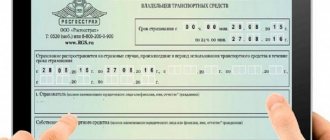Do you want to take a test based on the article after reading it?
Not really
The law on the electronic MTPL insurance policy was not adopted as such; legislators in 2015 adopted only amendments to the already existing Federal Law No. 40 “On MTPL”, as it is popularly called. It was thanks to these amendments that such an innovation as electronic insurance appeared. Some insurance companies echoed the new trends and voluntarily introduced an online registration service, while others ignored the possibility of remote registration for various reasons. However, already in January 2017, another amendments came into force - what interesting things did they bring?
Paper or digital?
The law does not distinguish between policy forms. Both of them certify the fact of concluding an agreement (see paragraph 7 of Article 15 No. 40-FZ).
The first one is protected from counterfeiting by special printing methods and is issued on a strict reporting form. The electronic MTPL policy exists only in the form of a digital record, is signed by the insurer’s electronic signature certified by an independent center, and can be checked using a single Internet database.
Remember! An insurance policy issued in the form of a digital document is equivalent to a paper policy executed on a strict reporting form.
You no longer need to print out the electronic MTPL policy
So, that’s it, the situation with electronic MTPL contracts and traffic police officers has been finally resolved. From January 2 of this year, policies can already be presented for verification from a mobile device. All disagreements were resolved by the changes to the traffic rules that came into force.
Now the Traffic Rules clearly state that if an electronic contract is concluded, the insurance policy can be presented “in the form of an electronic document or a copy thereof on paper .
Such changes were announced back in August last year. It took five months for them to undergo examination, approval by the Government and approval by the Ministry of Justice. In theory, they should have been accepted by the end of October. Since at the end of October amendments to the law on compulsory motor liability insurance began to take effect, which already indicated that an electronic compulsory motor liability insurance policy can be presented in electronic form .
However, disagreements were observed before, before inconsistency arose between the traffic rules and the law on compulsory motor liability insurance. A little over a year ago, the traffic police tried to remove them. However, instead of securing the status of an electronic document in the 21st century, the department consolidated the status of a paper medium : on December 8, 2018, the Traffic Rules clarified that in the case of an electronic policy, you must carry a printout of it with you .
Now, as of January 2, 2020, this clarification has been removed.
Was it worth introducing it for a year, if already on December 8, 2018 it was known that changes were being prepared to the compulsory motor liability insurance policy, which should “legalize” the electronic contract ?..
The traffic police clarifies that now an electronic policy can be presented from any electronic device that allows this . In case of any doubtful situations, a traffic police officer can contact the automated compulsory insurance information system and thus verify the authenticity of the document.
He will be able to do this using a unique number, which is assigned to each concluded policy, regardless of whether it is issued on paper or electronically. This unique number, along with all the information from the contract, is entered into the automated system.
We would like to remind you that electronic MTPL policies began to be sold on July 1, 2015 .
From January 1, 2017, insurers were obliged to give clients the opportunity to conclude contracts electronically.
Now only a little more than half of the policies are issued on paper : the share of e-MTPL at the end of 2019 was 45.7% . Moreover, specifically in January last year, the number of electronic policies even exceeded the number of paper ones.
What does electronic car insurance look like?
Any digital document is an intangible thing, physically non-existent. This is a file, a collection of information (data) intended for processing by a computer. Such a document can only be read on a digital device, using special software. A person cannot independently perceive digital data, but it is necessary to work with information, so the user is given the opportunity to make a material copy of the document - print it.
A printout of an electronic MTPL policy looks the same as insurance issued on a strict reporting form. All details and information will be in place, in strict accordance with the requirements of the rules (Regulation N 431-P, 09.19.2014 Appendix 3). Depending on the insurance company, the graphic design of the insurance will be simplified or completely replicate the paper form.
From January 1, 2021, a two-dimensional QR code will be displayed on the e-OSAGO printout. With its help, it will be possible to check the accuracy of the information specified in the insurance, without the need to enter identification data into the web form manually.
Concluding a contract in the form of a digital document does not exclude the possibility of receiving a copy of the policy from the insurance company on a secure form. (see paragraph 7, clause 7.2, article 15 No. 40-FZ)
Questions about e-OSAGO
Despite the fact that the possibility of obtaining compulsory motor liability insurance in electronic form was introduced back in 2015, many questions still arise about this, and they mainly concern how exactly such insurance works and whether it is legitimate.
It’s worth saying right away that electronic OSAGO has no differences from paper OSAGO, even the price remains the same. It begins to operate immediately upon receipt by the policyholder. A copy of the paper is sent to the specified email, but it continues to be stored in your personal account on the insurer’s website. If a paper policy is more familiar, you can always order it by mail, paying the shipping costs, and after a few days the strict reporting form will arrive at the specified address.
Another important question is what to show the traffic police inspector when he stops a vehicle to check documents. In clause 7.2 of Art. 15 states that a document received electronically is equivalent to a paper document. This means that you can simply print it out in order to present it both when checking documents and during registration actions at the MREO. The fact is that now traffic police departments and inspectors have a dedicated channel for checking the authenticity of compulsory motor liability insurance in the RSA database, therefore the presence of a strict reporting form is not a mandatory fact.
0
What to show to the traffic police inspector
Unfortunately, to date, no changes have been made to the traffic rules that clearly oblige traffic police officers to accept a printout of “e-insurance” as proof of compulsory motor liability insurance. Failure to have an “insurance policy” still results in fines and parking. They are trying to correct this situation with departmental clarifications. The average car owner does not always know about them. Unscrupulous inspectors often take advantage of this for personal gain.
Such employees need to be reminded that according to the administrative regulations, in order to confirm the electronic compulsory motor liability insurance, the driver must present to the traffic police inspector only a printout of the policy (Order N 664, 08/23/2017, clause 6.11).
What are the advantages of electronic MTPL?
There are practically no external differences between the new format and traditional insurance, but there are some features:
- the paper version is printed on Goznak letterhead, the electronic version is provided as a file;
- no micropattern;
- The digital version can be either color or black and white.
Virtual insurance has legal force. There will be no problems when checking documents, since traffic police officers have access to the all-Russian IMTS database of the Ministry of Internal Affairs of the Russian Federation. You can check your insurance policy within a few seconds by entering the vehicle VIN or car registration plate.
The obvious advantages of electronic insurance also include:
- no need to constantly carry a paper document with you;
- eliminates the possibility of document loss;
- When applying for a policy, you can select additional options;
- quick registration process without the need to visit the office;
- the ability to independently choose an insurance company.
The main reason for the growing popularity of virtual insurance is saving time, since often, due to busyness, car owners forget to stop by the insurance company’s office. If you don't have insurance, you can get a serious fine. If you want to avoid such situations, then set aside just five minutes of free time. You can issue an electronic MTPL policy via the Internet at any convenient time, including on weekends and holidays.
How to check authenticity
If you independently, without intermediaries, bought an electronic MTPL policy on the company’s official website, you just need to verify its authenticity by checking the insurer’s electronic signature. As a rule, the document file is sent to the policyholder in pdf format. This format provides the ability to sign documents with an enhanced digital signature. Most pdf viewing programs do a great job of checking it. You may need to further customize the program by following the instructions posted by the insurance company on its pages.
If such verification is not enough for you or you purchased insurance from a dealer, intermediary, or agent, you should make sure that the information indicated on the printout corresponds to the information that was reported to the insurance company. Perhaps your car “on paper” is a motorcycle from the Ryazan region, and you were so happy about the savings on insurance. The electronic policy should be checked on the official website of the insurer or contact the nearest office.
By the way, purchasing paper insurance does not guarantee protection against fraud. You can check the “legitimacy” of the form through the PCA service; the compliance of the information is with the insurer.
The law on compulsory motor liability insurance, amended in favor of insurers, came into force
Photo: Kirill Zykov/AGN Moscow On October 29, a new version of the law on compulsory motor liability insurance came into full force. The amendments were adopted by parliament and signed by the president this spring. Some of the provisions have already entered into force.
Important changes concern the list of situations in which the insurer receives the right of recourse against the culprit of an accident. Now motorists are threatened with recourse claims for refusing a medical examination and for using alcohol, narcotic or psychotropic substances after an accident. At the same time, it is stipulated that a recourse claim for compensation for damage caused to a vehicle cannot be presented to the injured pedestrian at fault (in case of death - to his relatives and heirs).
The insurer also receives the right of recourse if, when applying for a policy, the policyholder provided false information that led to an unreasonable reduction in the premium (for example, he underestimated the engine power or deliberately changed the region). The automated MTPL information system provides additional protection measures against this type of fraudulent schemes. If, when concluding an electronic contract, inaccurate information is revealed, the system will block the ability to pay the premium until the data is corrected.
Let us recall that one of the main innovations of the law on compulsory motor liability insurance is that paper and electronic policies are equal in status. It has been established that for verification at the request of traffic police officers, the insurance policy can be presented in both forms. This eliminates the need to produce policies on strict reporting forms, and each document is assigned a unique serial number. As a result, it is enough to present a printout of the electronic policy on plain paper or name its number and the insurer with whom the contract was concluded.
In addition, the procedure for processing documents about road accidents without the participation of police officers using special software with satellite navigation has been clarified. It is possible for drivers to prepare an electronic notification of an accident through the Unified Government Services Portal. In addition, the list of competent authorities that can issue documents confirming the occurrence of an insured event has been expanded. These now include not only the police, but also emergency services that go to the scene of an accident. As well as medical organizations.
Changes 2018-2019 to No. 40-FZ
On April 28, 2021, changes to OSAGO came into force. The 2021 Federal Law on Compulsory Motor Liability Insurance has decided that a policy can be issued for a period of less than one year. Claims can be made against insurance companies within 10 days, and independent examinations are now prohibited, since their conclusions are often not objective.
Another important change was the introduction of so-called compensation in kind, when money is transferred not to the owner, but to the account of the service station that carries out the repairs. Moreover, each insurance company works with certain service stations, the list of which is available. As for the maximum payments under the European Protocol, there have also been positive changes. Now they amount to 100,000 rubles. If the repair costs more than 400 thousand rubles, then the car owner has the right to monetary compensation.
Since the beginning of 2021, the concept of an electronic policy has been introduced, which can be purchased on the Internet. Financial penalties are being introduced for false information provided by the owner when purchasing an electronic document.
These are the main changes to Federal Law 40 on compulsory motor liability insurance, but the detailed development of a large number of nuances that continue to worry car owners continues.











